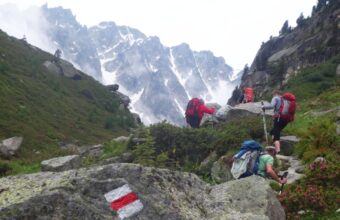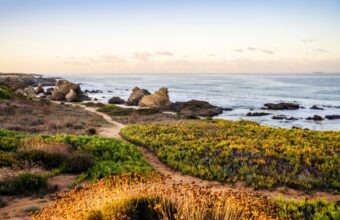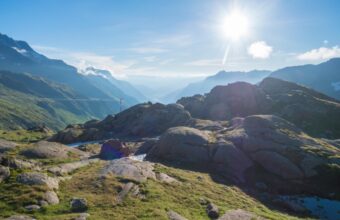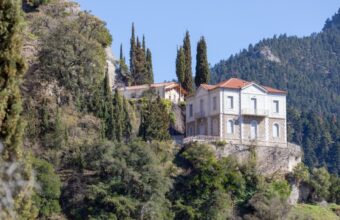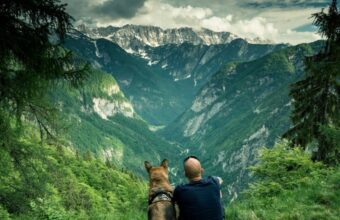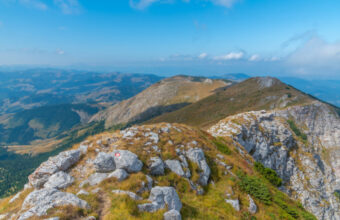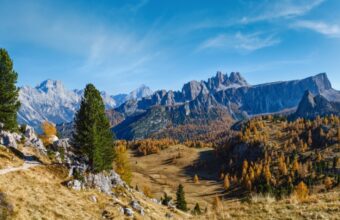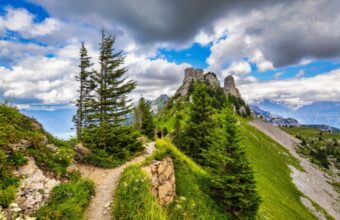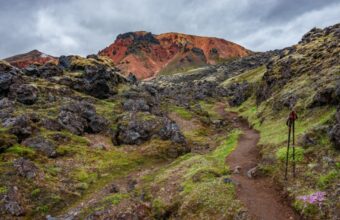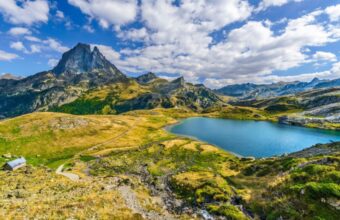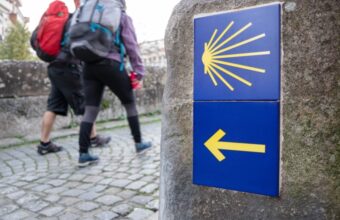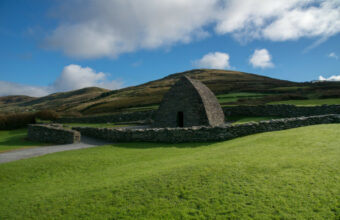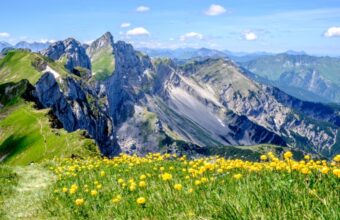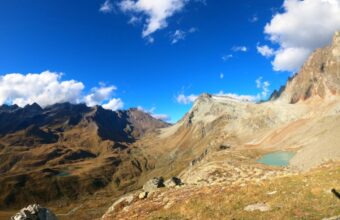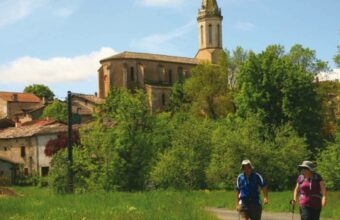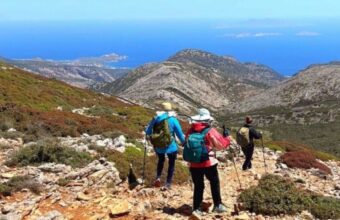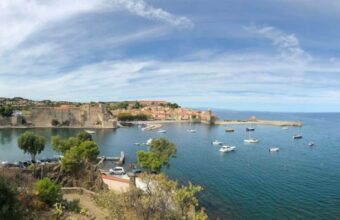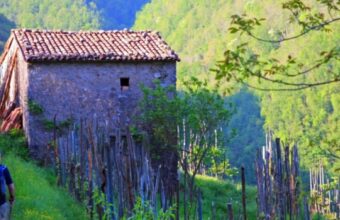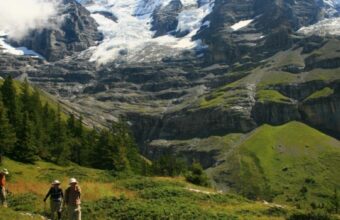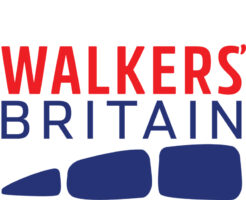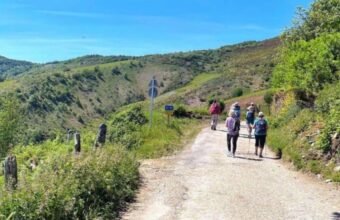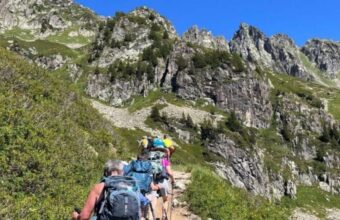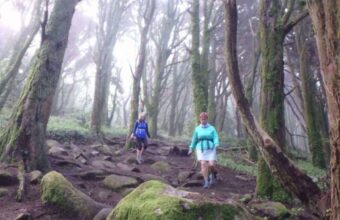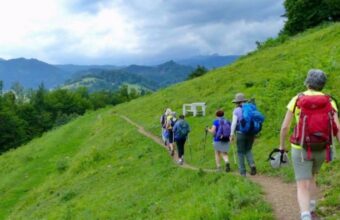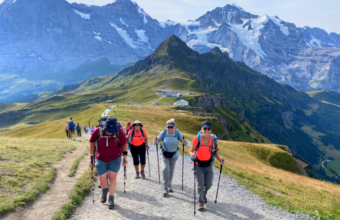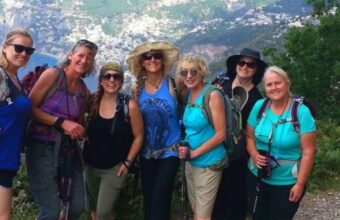The best walking holidays in Europe
An expert guide to the best hikes and walks in Europe
Ask any group of keen walkers to name Europe’s best hiking hut and you’ll poke a hornets’ nest. Each will vociferously champion their choice, citing the richest fondue, the iciest beer, the most jaw-dropping views, the cleanest loos.
Mine is the homely Auberge de la Nova in Les Chapieux, on the Tour du Mont Blanc: the food is hearty, the café courtyard sunny and shady, the surroundings pleasant. But the trump card is soundproofing: I slept the slumber of angels in my private room, free from the unearthly, brain-penetrating snoring of my previous night’s bunk companion that I knew would be ravaging the nearby dorm. Bliss.
The dizzying number and variety of mountain huts, refuges, gites, guesthouses and other walkers’ accommodation is just one factor that makes walking holidays in Europe a delight. Another is the diversity of landscapes, cultures and cuisines. I’ve sipped coffee with octogenarian chess wizards amid Turkish olive groves, snacked on goose barnacles in Portuguese fishing hamlets, bought cheese from a Pyrenean shepherds’ milking-shed beneath snow-dusted peaks, and quaffed wines at from cellar doors alongside the Moselle and the Rhône, in Catalonia and North Macedonia – all while walking Europe’s exceptionally well-maintained hiking trails.
Sure, there are loftier mountains, deeper canyons, more remote wildernesses to be found elsewhere. But there’s no other region that packs this much diversity in such a small area, and with such well-developed infrastructure. Here you can trek around 4,800m-plus peaks or amble for hundreds of kilometres alongside meandering rivers. You can explore highlands snuffled by bears, wolf-prowled woodland, and coasts past which dolphins porpoise. En route you can visit archaeological sites dating back five millennia and more, roam Roman remains, circuit mediaeval castle walls or trace the remnants of the Iron Curtain. And all set in landscapes ranging from volcanic craters to ancient forests, vine-striped hills to soft-sand shores lapped by the turquoise Mediterranean.
Life’s made easier for hikers here, too, thanks to long-established traditions of walking – or, to put it in local terms, of wandern, randonée, caminando, fotturer and pohodništvo. Europe is criss-crossed by an unrivalled network of trails, many of them well waymarked, and including 12 official E-paths (see below). And in some places, including Norway, Finland, Scotland and Estonia, a longstanding ‘freedom to roam’ principle means that most uncultivated areas are fair game for walkers – you can explore at will, while respecting the land and its owners, of course.
Where to go walking in Europe
Our experts' top picks
With so much to choose from, trying to pick favourites feels like a fool’s errand. If pushed I'd say my best walking memories are in the Pyrenees, the Austrian Tirol and the Italian Dolomites, but all the following are well worth your consideration.

French Pyrenees
The Pyrenees
The magnificent range separating France from Spain stretches over 400km from the Mediterranean to the Bay of Biscay, where it nudges the Cantabrian mountains. Though its peaks don’t scale the heights reached by the Alps – the tallest is Aneto at 3404m – the massif is a treat for walkers, with numerous waymarked long-distance routes at varying altitudes and levels of challenge, and far fewer feet tramping those trails.

Balkans
The Balkans
Southeast Europe and the Balkans offer some of the finest mountain hikes in Europe.
There are some superb long distance hiking trails in the Balkans, several of which I’d include among my favourite walks anywhere in the world – yet for the most part, they are much less-known than routes in the Alps or the Pyrenees, and see far fewer visitors. The more remote routes require a bit more confidence and experience than some of Europe’s better known mountain playgrounds – but this is at the same time one of their great draw-cards.

Portugal
Rota Vicentina, Portugal
Portugal promises great value and crowd-free walking holidays with fascinating history and excellent food & wine to boot.
The Rota Vicentina comprises twin trails running north from the western Algarve through the Alentejo: the inland Historical Way and – my pick – the 226.5km coastal Fishermen’s Trail, traversing ancient cork-oak woods, wildflower-spangled cliffs and charming fishing villages. Both are blessed with good accommodation en route.

Tyrol Mountains
Austrian Tirol
The westernmost finger of Austria, sandwiched between Bavaria and northern Italy, is essentially all mountain – the Tirol (and its westerly neighbour, little Vorarlberg) is a coherent picture of classic Alpine scenery.
The Tirol’s flagship long-distance trail is the Adlerweg (Eagle’s Way), a challenging 300km trek between St Anton and St Johann; variant routes allow less-experienced trekkers to bypass the more technical sections. The Stubai Höhenweg is a beautiful 55km, six-day high-level hike between huts perched above the namesake valley south of Innsbruck – not easy, but not technical and accessible to most fit walkers.

Dolomites
Italian Dolomites
In Italy’s far northeast, soaring limestone shards pierce the sky in jagged pinnacles and ridges reminiscent of the mountains of Patagonia, set ablaze by the setting sun in the characteristic enrosadira or alpenglow. I'd argue the Dolomites, are the most beautiful section of the Alps, with a character distinct from neighbouring massifs in geological, cultural and linguistic terms.
Six waymarked Alta Via (High Route) trails wind roughly north-south through the Dolomites; of which the 120km Alta Via 1 (AV1) is the easiest and most popular.

Europe
Carpathian Mountains
Sweeping in a 1450km-long crescent from the Czech Republic and western Slovakia, the Carpathians skirt southern Poland and curve through southwestern Ukraine and across the middle of Romania to the Serbian border. The High Tatra mountains, on the Polish-Slovakian border, have become known for good-value skiing but are also blessed with well-marked hiking trails and mountain refuges, while Romania’s Făgăraș and Retezat Mountains are wilder and far less visited.
Tatranská magistrála is the classic three-day traverse of the High Tatras, a waymarked 49.5km route from Podbanské to Skalnaté.

Europe
The Alps
No roundup of Europe's walking hotspots can ignore the continent's greatest and most famous mountain range.
The Alps stretch some 1,200 km from east to west and span more than half a dozen countries – so not surprisingly, they’re home to some of the finest hiking trails and most sublime scenery that the continent has to offer.
The Tour du Mont Blanc draws all the crowds, but there's so much more to walking here.

Ireland
Ireland
From the towering cliffs of the Wild Atlantic coastline, to ancient, glacier-carved valleys, forgotten peninsulas and the impressive peaks of the MacGillycuddy’s Reeks, Ireland is a walking holiday paradise.
Whichever corner of Ireland you find yourself in, you won’t have to travel far to find an empty beach or green fields for a breath of fresh air. There aren't many countries so perfectly-made for bracing hikes and easy-going rambles.
The best walking holidays in Europe
Europe's most popular – and lesser known – walking holidays
I can never get enough of walking in Europe – not least because it’s in a constant state of reinvention and renewal. It’s over 250 years since the Tour du Mont Blanc was pioneered by mountaineer Horace Bénédict de Saussure, now joined by stripling trails springing up year by year. Here are just a few of my favourite European walking routes.
-
Switzerland
View trips -
Portugal
View trips -
Tyrol Mountains
-
Greece
View trips -
Slovenia
View trips -
Montenegro
View trips -
Dolomites
-
Switzerland
View trips -
Iceland
-
France
View trips -
Santiago de Compostela
View trips -
County Kerry
-
Tyrol Mountains
-
Switzerland
View trips
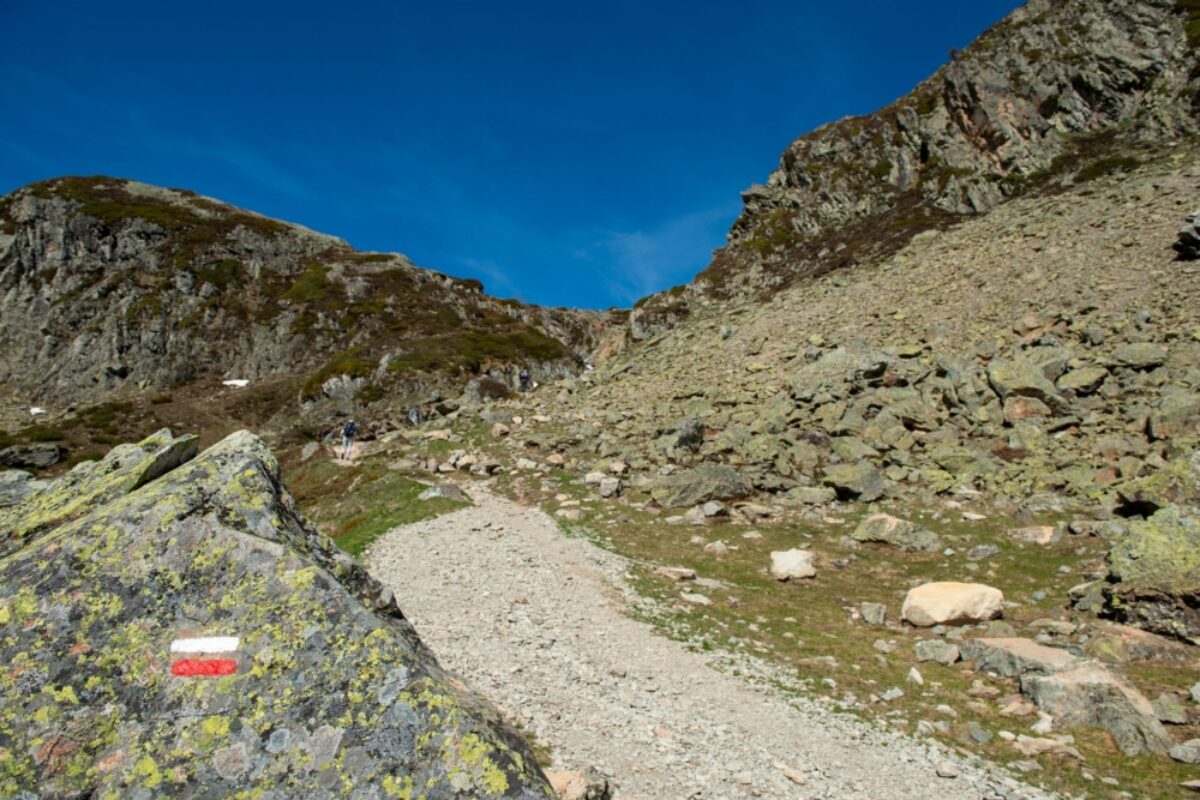
Europe's network of Grande Randonées (great hike) footpaths are waymarked with easily-recognisable red and white stripes
Planning a walking holiday in Europe
Everything you wish you’d known before you booked
Avoiding the crowds
Europe is a famously popular and, in places, crowded travel destination. Escaping the bustle on a walking holiday in Europe's more-remote corners is a good way to escape the day trippers, tour buses and cruise ships that plague the continent’s busier hotspots.
That said, even Europe’s walking destinations can fall foul of tourism booms. Certain routes, such as the Tour du Mont Blanc and the Camino Frances, have become increasingly popular in recent years, and soaring demand means that even dorm beds in mountain huts can get booked out many months in advance. Plan well ahead, or try an alternative. Perhaps try the shorter Tour des Combins instead of the Tour du Mont Blanc, or tackle the Camino Primitivo rather than the Camino Frances.
If you do hike the more popular routes, start early each morning and expect long lines at pinch-points and snaking up steep passes. Stock up on food beforehand in cheaper spots, and take earplugs for noisy dorms.
What's in a name?
Europe's 12 official "E-paths" are a network of trans-national long-distance paths designated by the European Ramblers Association (www.era-ewv-ferp.com). Some routes span over 10,000km; the E1, for example, stretches from the northern tip of Norway through Sweden, Denmark, Germany, Switzerland and Italy, ending in northern Sicily. Of these E-paths, many sections comprise shorter (but still multi-day) numbered Grande Randonées (great hikes); you’ll see the familiar white and red horizontal stripes of GR routes painted on rocks and trees, mostly in France, Spain, Belgium and the Netherlands but also elsewhere in Europe.
Europe walking holiday types
Broadly speaking, European walking holidays fall into three categories: fully independent, self-guided and guided. The first is self-explanatory: you do all the planning, booking and navigating yourself, carrying your luggage along the trail. Clearly, this reduces costs and can be enormously satisfying for the hardier hiker. For most European hiking destinations you’ll find an abundance of information to help both pre-trip organisation and on-the-ground efforts. However, it involves forward planning and some mastery of navigation – you’ll need to be self-reliant en route.
Guided walking holidays
A guided trip, whether joining a group of like-minded strangers or booking a package for yourself or your family, is ideal for first-time trekkers, solo travellers and those venturing to more remote or challenging destinations. Accompanied by an experienced guide, with all accommodation and transport pre-booked and, usually, luggage transferred between stops, you need worry about nothing but enjoying the walk; it’s also a great way to meet new friends. Naturally, it’s significantly more expensive.
Self-guided walking holidays
An excellent in-between option is a self-guided hike. Typically, all accommodation is pre-booked, usually including breakfasts and, sometimes, dinners (less commonly lunches); luggage is transferred between overnight stops; you’ll receive maps and detailed route notes; local telephone support may be available; and transfers from/to airports or other transport hubs may also be included.
There’s a greater degree of flexibility in terms of pace, duration and daily distances. Self-guided trips are available for many well-known long-distance trails across Europe, or shorter sections of them, most commonly less-challenging routes. For reasons of cost, safety and enjoyment, self-guided trips are best suited to couples or small groups of friends, though solo hikers also benefit.
Hotel-to-hotel vs centre-based walking holidays
Finally, a decision for self-guided walking holidays is your preferred format, either inn-to-inn or centre-based.
Long-distance hikes usually move from one place to another each day, staying in hotels or inns, hostels or mountain huts, or even camping. Alternatively, you may choose to base yourself in one place, taking transfers to trailheads each morning then returning to the same accommodation each night, thereby avoiding the need to repack your luggage each morning.
Some tour operators offer the option to mix these approaches, staying in each base for several nights but moving between accommodation as you progress along a trail.
Europe walking FAQs
Your questions, our expert answers
Question
When is the best time to go walking or hiking in Europe?
Answer
High trails in most European mountain ranges open only during high summer, when they’re free from snow – typically late June to September. Of course, the weather can turn even then – I’ve waded through thigh-deep drifts in August in the Austrian Tirol. Hiking the Greek Islands, Turkey, Catalonia or the Portuguese coast is best in spring or autumn; in winter, head for the Canary Islands, Madeira or Andalucía.
As the warmest, driest weather typically also coincides with peak tourism season, I generally advise people to go in the “shoulder season” either side of high summer.
Snow covers most mountain trails over about 1,500–2,000m between late September and early to mid-June, depending on location; mountain huts/refuges tend to open only during that period, effectively defining the trekking season.
The best Europe walking holidays in Summer
August is usually the busiest month, so availability of accommodation is often better and paths more peaceful in late June/early July or September. For summer, consider the Alps, the French Pyrenees, Scandinavia, the Carpathians or the mountains of the Balkans, as well as river routes such as the Moselsteig and Danausteig (Danube Trail) in Germany and Austria.
High summer is too hot for hiking in much of Greece, Provence, Italy, southern Spain and Portugal, coastal Croatia and Albania. Here, spring rewards walkers with cooler conditions and wildflowers spangling meadows and trails; Spain’s Alpujarras and Mallorca are strewn with almond and orange blossom, and Catalonia is warmly enticing. Keep in mind that northern Portugal and Spain receive a lot of rain in spring and autumn; not for nothing is Galicia, through which the latter stages of the Camino de Santiago run, known as the heart of España Verde – ‘Green Spain’.
The best Europe walking holidays in September & October
Autumn brings blazing fall foliage and, in wine-producing regions, grape-harvest festivals. The Czech Republic and Slovenia are great for hiking in September and October, while Portugal’s Douro Valley and the hills of Tuscany, both striped with vines, are treats for trekkers in autumn.
Walking in winter
For winter walking in warm sunshine, head to Madeira or the Canary Islands – the dramatic volcanic landscapes of La Gomera, La Palma and Tenerife are laced with footpaths. Alternatively, crunch through crisp snow on dedicated winter trails in Bavaria or Austria; many Alpine regions are well set-up for cold-season hiking.
Question
What are your favourite walks or regions, and why?
Answer
My old boss – a former trekking guide – once described the Pyrenees as being ‘seven and a half times as beautiful as the Alps’. He’s not far wrong; as well as harbouring pockets of unique culture (try the Val d’Aran, where the ancient Occitan dialect is still spoken), its trails are much quieter and wilder. That said, the less-tramped paths of the Austrian TIrol and the Italian Dolomites are hard to top.
Question
What sort of accommodation should I expect on a Europe walking holiday?
Answer
Camping is possible on most routes but usually unnecessary, except in particularly remote stretches of, for example, the Romanian Carpathians. Most European countries with good mountain trails have a well-developed network of simple, comfortable and cheap accommodation in dormitories. They offer either individual beds, bunks or, in matratzenlager/dortoirs, oversized mattresses big enough to sleep several people; you’ll usually need to bring your own sleeping bag or sheet sleeper (where blankets are provided). Some offer showers and good food; others, in spots such as Bulgaria, may have no hot water and only basic squat toilets – but are usually in spectacular locations.
Private rooms may be available in such huts, particularly in France, Italy and Switzerland.
On pilgrimage trails, notably the Camino de Santiago in Spain and Portugal, basic albergues (hostels) cater exclusively to pilgrims who carry a credencial (pilgrim passport). Wherever you trek, apart from on high mountain trails (and sometimes even there), you’ll find comfortable gîtes d’étapes (walkers’ guesthouses, often in a town or village), guesthouses, B&Bs and hotels.
Prices vary enormously: a dorm bed in a refuge in Bulgaria or an albergue in Spain might cost as little as €7 or €8, though you’ll pay two or three times that much in equivalent refuges in France or mountain huts in Austria, still more in Norway and Switzerland. Half-board options are generally good value, and sometimes mandatory, in such places. B&Bs and hotels start from about three times those prices – say, £25 per double room at the cheaper end, three or four times as much in pricier destinations.
If you opt for an organised trip with a Europe walking holiday specialist, many of these details will be taken care of on your behalf. Depending on the operator and location you may have options to tailor your accommodation standard (and budget), and things like meals and baggage transfer will be arranged for you.
Question
How much does a Europe walking holiday cost?
Answer
Prices for self-guided trips are surprisingly uniform at around £100/€115 per day – a little less for cheaper destinations such as Albania, Poland, Portugal and Spain, a little more for Switzerland, Iceland and Italy. Differences are greater between tour operators, and to an extent depend on the level of accommodation offered – obviously, dorms in mountain huts cost less, comfortable hotels more – but not as much as you might expect.
Guided tours vary more widely, because staff costs are much higher in countries such as Iceland, Norway and Switzerland, and lower in Slovakia and Bulgaria, where prices for guided trips can be under £100/€110 per day.
You’ll also typically need to factor in the cost of transport to the start of the walk, local transfers, tips, insurance (covering treks to the maximum altitude on your route) and any additional food and drinks – a cold beer, glass of wine, ouzo or raki is a wonderful way to round off a day’s hiking.
Question
Can you recommend the best Camino?
Answer
The vast majority of the half-million-ish peregrinos (pilgrims) who tramp to Santiago de Compostela each year follow the Camino Frances, the mostly gentle trail across northern Spain from St Jean-Pied-de-Port on the French border. In my opinion it’s fine, though in the main not visually dramatic, and pretty busy. But it’s also far from the only option: there are a good half-dozen trails heading north through Portugal, plus others through Spain. I’d opt for the original route, dubbed the Camino Primitivo, trekking 200 miles from Oviedo through the Asturian Hills – much more peaceful and challenging.
Question
Can you recommend anywhere like the Alps but less popular?
Answer
Word is getting out about the Albanian Alps – sometimes dubbed the ‘Accursed Mountains’ – which remain much less developed, but also boast soaring karst peaks with forest-clad flanks and traditional villages. Slovenia’s Julian Alps are developed in patches, particularly the northern and eastern regions, but it’s simple to escape crowds – head high or west, towards the Soca Valley.
Question
What are the hardest and easiest walks in Europe?
Answer
The GR20 tracing the jagged spine of Corsica has a reputation as a major challenge – not just because of tough terrain and hefty ascents, but also because you’re a stiff haul from the nearest settlements for much of the route.
Coastal walks along Italy’s Cinque Terre are pretty but fairly easy. Germany riverside trails tend to be, unsurprisingly, less physically challenging; try the Moselweg.
Question
Where are the best places for self-guided walking holidays in Europe?
Answer
Switzerland is almost too easy: in popular walking regions such as the Bernese Oberland, frequent yellow waymarkers indicate destinations and astonishingly accurate walking times, so it’s pretty much impossible to get badly lost, and very safe (though pricey, of course). You won’t be alone for long on the Camino Frances, the most commonly followed pilgrimage route to Santiago de Compostela through northern Spain, either.
Question
Can you recommend any places for a cheap walking holiday in Europe?
Answer
Portugal offers great value for walkers: in many places you’ll still pay just €1 for a coffee, not much more for a cold beer, and delectable food is served in generous portions. You’ll get a relatively big bang for your lev or euro in Bulgaria or Slovakia, too.
Question
I don’t speak any European languages, will it be easy to travel?
Answer
It varies. In much of Scandinavia, Germany, Austria, Switzerland and Slovenia, no problem – English is almost universally spoken, certainly in hiking areas. You’ll easily find English-speaking guides in other popular trekking regions, including parts of the Balkans, Turkey and Greece. If you’re solo walking in France, Spain, Italy or Portugal, you’ll want to learn even a few words of the local lingo.
Question
What should I pack for a walking holiday in Europe?
Answer
It’s vital to don the right pair of boots or shoes, and wear them in before setting out: a blister or bruise sustained on day one can ruin the whole trip. Mountain treks generally call for boots with ankle support and rugged soles (typically Vibram); leather, which needs more wearing in, is preferably to fabric in these conditions, though the latter is fine for lower-level or warm-weather walks, preferably with a Gore-Tex or similar breathable waterproof lining. Good socks are also essential: merino wool is best, for socks as well as T-shirt base layers, reducing odour and remaining comfortable and warm when wet.
If you’re carrying your own luggage between overnight stops, choose a hiking-specific rucksack with good hip and shoulder support. If you’re on a supported trek that includes luggage transfers, take a soft-sided duffle bag and a 30–35L daypack. Whichever backpack you choose, ensure it takes a hydration bladder – on most trails you’ll drink at least 2L of water each day. A water filter or purification tablets is useful for filling bottles from mountain streams.
Lightweight, adjustable, packable walking poles are handy, particularly if you’re carrying a large pack or undertaking steep or extended descents; flick-lock extension systems tend to be more robust than twist-lock. Black Diamond and Leki are respected brands. A breathable waterproof jacket is essential in most destinations, particularly in mountain regions where weather can change rapidly, along with a hat, sunglasses, sunscreen and a basic first-aid kit for treating blisters, cuts, sprains and stings.
Question
Are wild animals a problem while walking in Europe?
Answer
Though wolves and bears roam the wilder expanses of Europe’s highlands, you’re unlikely to encounter one. What you might come across, though, are shepherds’ dogs bred and trained to ferociously defend livestock against predators – and human interlopers – particularly in the Carpathians, Balkans and Caucasus. I’ve suffered unnerving canine encounters in Bulgaria and North Macedonia, where I was thankful to have experienced local guides – also my trusty walking poles. (While we’re talking animal hazards, tick-removal tools are must-packs, too.)
Further reading
Useful Europe walking resources
Several publishers produce excellent, detailed guidebooks for specific treks or regions, including maps and route notes:
Cicerone produces the most comprehensive list of trekking and walking guides, covering many long-distance trails worldwide including most of the main European routes.
Trailblazer guides are expertly researched, with helpful hand-drawn maps, reducing confusion where waymarks are ambiguous. The list is particularly strong on British trails, but also features some international treks.
Sunflower publishes collections of day-walks for a host of destinations, including much of Europe.
Numerous local and regional organisations provide advice and practical resources.
The Austrian Alpine Club manages hundreds of mountain huts in Austria and has reciprocal arrangements with similar organisations in other European countries. The website of the UK branch has plenty of information for hikers and mountaineers.
The European Ramblers Association has details of the 12 ultra-long-distance E-Paths as well as routes classified as Leading Quality Trails, and describes the four dominant systems of waymarking across the continent.
The Confraternity of St James provides information on the various caminos to Santiago plus other European pilgrimage trails.

